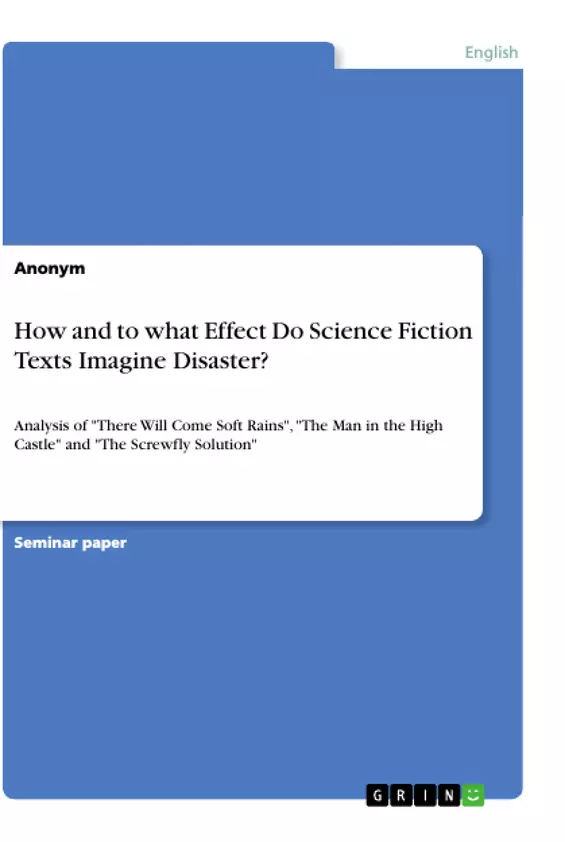This essay aims at calling attention to the ravages of power relationships, which drive disaster and subsequently the ascendance of dystopian/post-apocalyptic worlds in the texts chosen.
“All responsible writers have become involuntary criers of doom, because doom is in the wind; but science fiction more so, since science fiction has always been a protest medium” , the renowned author Philip K. Dick commented on the purpose of writing science fiction. Science fiction offers writers a platform to emphasise and magnify social inequalities, target issues, identify victims and encourage change. The texts discussed in this essay include: Ray Bradbury’s short story “There Will Come Soft Rains” which tells of a technically elaborate house that seems to be the lone ‘survivor’ after an atomic blast; Philip K. Dick’s novel The Man in the High Castle that imagines a world in which the Axis powers triumph over the Allies and totalitarianism is established as the prevailing governmental system; and third, Raccoona Sheldon’s short story “The Screwfly Solution” which describes the devastating effects of a pandemic that causes men to kill off womankind.
First, the terminology relevant to this essay will be established in order to provide a better understanding of the terms used. As the function of this essay is to analyse how and to what effect science fiction texts imagine disaster, the main part will be divided into two sections. In the first section, the portrayal of disasters in the three texts will be explored by looking into the power relations which inform the conflicts. In the second part, the effect of the emergence of dystopia will be discussed by reflecting about the texts’ intentions. The main ideas will be summarised in a final conclusion.
Inhaltsverzeichnis (Table of Contents)
- Introduction
- Terminology
- Disaster
- Power Relations
- Dystopia
- How do science fiction texts imagine disaster?
- "There Will Come Soft Rains"
- The Man in the High Castle
- "The Screwfly Solution"
- To what effect do science fiction texts imagine disaster?
- "There Will Come Soft Rains"
- The Man in the High Castle
- "The Screwfly Solution"
- Conclusion
Zielsetzung und Themenschwerpunkte (Objectives and Key Themes)
This essay aims to analyze how science fiction texts portray disaster and the subsequent emergence of dystopian worlds, highlighting the role of power relations in driving these scenarios. It focuses on three texts: Ray Bradbury's "There Will Come Soft Rains," Philip K. Dick's "The Man in the High Castle," and Raccoona Sheldon's "The Screwfly Solution."
- The portrayal of disaster in science fiction texts
- The role of power relations in shaping disaster
- The emergence of dystopian worlds as a consequence of disaster
- The effects of disaster on social structures and individual lives
- The potential for science fiction to serve as a tool for social commentary and change
Zusammenfassung der Kapitel (Chapter Summaries)
- Introduction: The introduction establishes the essay's purpose, outlining its focus on power relations and dystopia in science fiction texts. It introduces the three texts under analysis: "There Will Come Soft Rains," "The Man in the High Castle," and "The Screwfly Solution."
- Terminology: This section defines key terms such as "disaster," "power relations," and "dystopia," providing a framework for understanding the concepts explored in the essay.
- How do science fiction texts imagine disaster?: This section delves into the portrayal of disaster in the three texts, examining the power dynamics that contribute to the conflicts and the resulting dystopian settings.
- To what effect do science fiction texts imagine disaster?: This section analyzes the impact of disaster on the societies depicted in the texts, exploring the social, political, and psychological consequences of the imagined events.
Schlüsselwörter (Keywords)
This essay explores the themes of disaster, power relations, dystopia, science fiction, social commentary, and the influence of power dynamics on societal structures and individual experiences. It analyzes texts that portray disaster as a result of technological advancements, political ideologies, and social inequalities, ultimately highlighting the potential for dystopian futures driven by unchecked power.
- Citar trabajo
- Anonym (Autor), 2018, How and to what Effect Do Science Fiction Texts Imagine Disaster?, Múnich, GRIN Verlag, https://www.grin.com/document/539317



